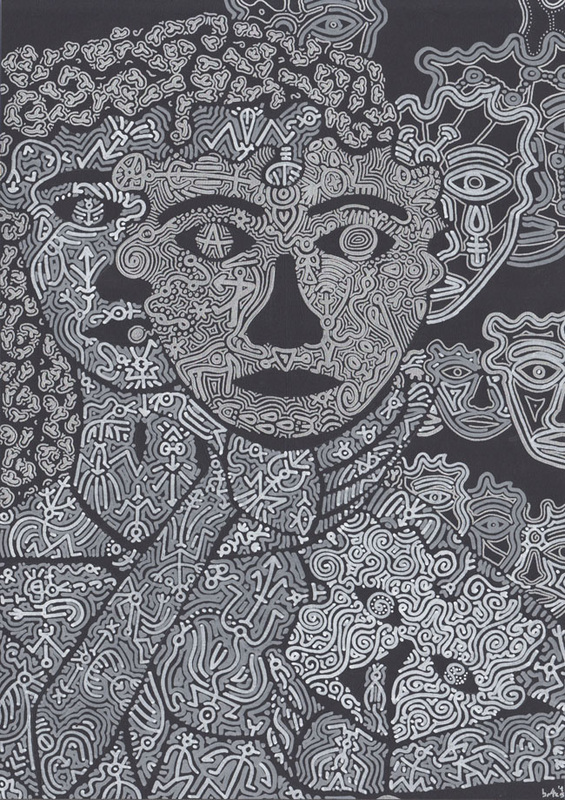Campbell's mythic definition of a symbol as being that which is “transparent to transcendence” established as basic formulation that a fundamental property of a symbol is extension of reference, that is to say, it moves beyond the directly perceptible or immediately verifiable into an unseen realm of meaning. McBrearty & Brooks mirrored this with a more functional definition as the cognitive ability to substitute people, objects and ideas with arbitrary referents, whose meanings are made real through cultural practice.
“A Dorze is no less careful to guard his animals on Wednesdays and Fridays, fast days, than on the other days of the week. Not because he suspects some leopards of being bad Christians, but because he takes it as true both that leopards fast and that they are always dangerous. These two statements are never compared... Leopards are dangerous every day; this he knows from experience. They are also Christians; this is guaranteed by tradition. He need not seek the solution of this paradox...”
Symbolic information is thus shielded from 'worldly' information of individual experience and as such the belief in the leopard's Christianity is maintained despite empirical evidence to the contrary. We see in this dichotomy evidence of our World-Beyond-Worlds narrated earlier: the world of unseen and unverifiable symbols and the world of the perceptually visible are fundamentally not the same. De Lumley underlines this point:
“Symbolic thought represents one of the essential dimensions of human cognition, transcending the material world and integrating cogitation within a universe richer than that of the senses, and combining concepts, that is to say abstract notions, into a system of complex relations.”
Knight, Power & Watts expand upon Sperber's view in light of the case of the baboon deceiving its pursuers and their immediate dismissal of the imaginary predator once its existence could not be verified, using this to liberate a technical but ingenious definition of symbolism that comes from a primate perspective, as it were, looking at human culture from the outside rather than from within. This liberated our third initial definition used earlier:
“The human symbolic domain... is a realm of indefinitely maintained collective ‘deceits’, collective ‘fantasies’... It is as if the gang of baboons in our example all looked, saw no predator – but then joined in with their deceiver in pretending to see one. Clearly, they would not be predicted to do this unless they had some collective interest in perpetuating the fantasy...”
It is this collective interest, as it were cooperative behaviour, which reifies the symbol, in their view. In an exploration of the import of mythology, Sperber concurs with this assessment:
“Individual works are all potential myths, but it is their collective adoption that actualises... their 'mythicism'.”
Knight, Power & Watts quote Chase in defining symbolism as that which “requires the invention of a whole new kind of things... that have no existence in the 'real' world...” and consider human cognition to be coloured (or distorted, in their words) by a communal map, a copy of which is held psychologically by each member of the community and possession of which denotes membership of that community. In this sense, the link between symbolic cognition and religious practice which benefits the social group rather than the individual is made explicit:
“Among modern humans, all behaviour and all cognition occurs in the context of this additional map... Implanted by external public pressure, the motivational bias of such communal cognition is sociocentric, countering the bias of egocentric vision. Onerous social duties are presented, paradoxically, as attractive, while opportunities for sexual self-indulgence are marked ‘danger’ or ‘taboo’.”
Chase further argues that human social systems cannot function without these symbolic ‘maps’ and communal cognitions. Here are found the keys which underlie the insight that no explanation which revolves around individualist interpretations of Darwinism can accurately narrate the emergence of symbolic culture, ritual, language or art because these ubiquitously human features do not focus primarily upon the drives of the individual. Their most significant effects are rather to reduce, rather than increase, inter-individual competitive behaviours. Knight underscores this point in an exploration of the nature of ritual:
“Ritual is collective symbolic action which in the most powerful way organises and harmonises emotions. Without this, there could have been no early human language, no 'kinship', no culture. A society which was a mere assemblage of egotistic, competing individuals would have no ritual domain and could not have one... It can be said that societies or groups value ritual to the extent that they value the maintenance of collective solidarity...”
In collective action, then, there arises collective identity, which becomes encoded throughout the group's emerging society, in systems of kinship, totemic bonds and memberships of religion. Furthermore, this collective identity facilitates a new kind of cooperative behaviour that moves beyond kinship (‘kin selection’ or genetic relationship) or 'reciprocal altruism', setting a more trusting social environment for innovations such as language to arise. Watts notes that ritually-founded collective identity liberates ideas of the 'in-group' and 'out-group', distinctions which may have contributed to a proto-symbolic reality among early hominids as well as aided with the emergence of true language:
“Because collective rituals are costly, they demonstrate commitment. A consequence of commitment is the generation of trust. Once you have a ritual community [an 'in-group'] within which there is sufficient trust, you no longer need costly signals for internal use – you can afford to develop cheaper, coded forms of communication. Costly ritual continues to be required for signalling to an 'out-group'... and for the incorporation of new members... into the ritual coalition. Human speech communities were born out of the regular performance of such costly displays.”
Resonating with much of this, d'Errico explores a collective but functional definition of religion as “a set of socially shared and transmitted beliefs encoding a group's understanding of the essence of reality” and quotes Geertz:
“[Religion is] a system of symbols which acts to establish powerful, pervasive and long-lasting moods and motivations in [humans] by formulating conceptions of a general order of existence, and clothing these conceptions with such an aura of factuality that the moods and motivations seem uniquely realistic...”
before noting that “in simple words, religion is about the deep symbolic content in life. Personal beliefs are of reduced interest here.”
We can readily see links with earlier discussions and the framework of an interesting picture is built up: Lewis-Williams' characterisation of the final stage of his 'intensified trajectory' as being of such powerful import as to be mistaken for reality, and the notion of the World-Beyond-Worlds being 'more real than real', resonate strongly with Geertz's words, while d'Errico's thoughts mirror Knight's image of the symbolic collective as working to suppress individual egotistic drives and create a sense of 'in-group' belonging. Here we also recall Eliade's model of the Eternal Return, in which individual 'profane' experience is dismissed in favour of a collective re-alignment with an 'eternal' sacred realm which is the primary source of meaning, and we note also the simultaneity enfolded into Sperber's paradox of the leopard.
However, Lewis-Williams and Eliade both belong to a venerable academic tradition which places primacy upon shamanism, visionary experience and 'archaic techniques of ecstasy' as the major factors responsible for the origins of religion, and even that shamanism forms a modern exemplar of the proto-religion of the Upper Palaeolithic. d'Errico departs from this tradition, considering that while shamanism (and hence visionary experience) was likely to have been practised in many early symbolic societies, this particular religious form should not be considered a universal of hunter-gatherer societies, nor that shamanism and the origin of symbolism should necessarily be linked.
Knight agrees, noting that the shaman is often conceived as bisexual, theriomorphic or transvestite, these being symbolic assessments that partake of a collective unreality and thus must have emerged, as it were, after the fact of symbolism itself. This causes us to require another possible origin of symbolism and symbolic cognition, and we can see that while we have here defined symbolism as primarily collective, it has not been made clear what powerful Darwinian motive could have arisen to drive the profound suppression of primate deceit strategies towards a collective level of trust and cooperation we see among humans everywhere.
Knight's view is that for trust to occur, it was necessary not merely to create symbolism, but to invent the deity, and thereby, as Kohn says, have a 'higher' power to swear by. But the ingenuity of his theory, developed further with Power & Watts, is that these powers and indeed all the strangeness of human symbolic culture, spring from a strict Darwinian view of human sexual behaviour, which from the point of view of every other primate – one might even say most other mammals – contains one extremely puzzling feature indeed!




 RSS Feed
RSS Feed






